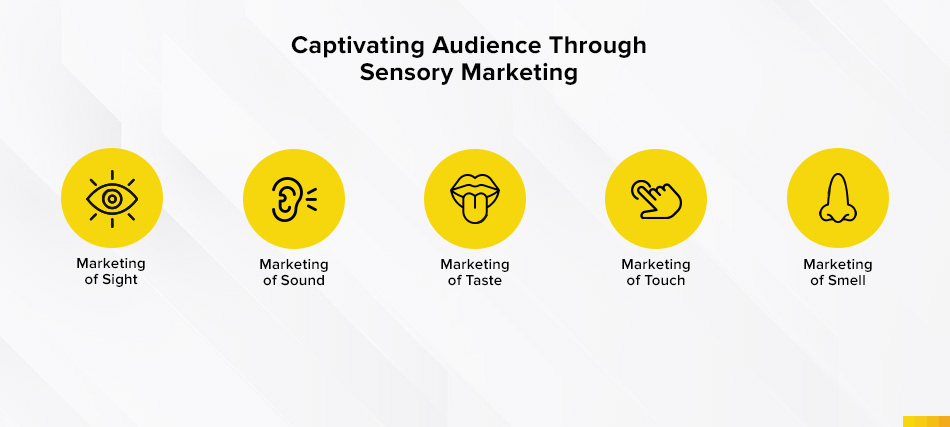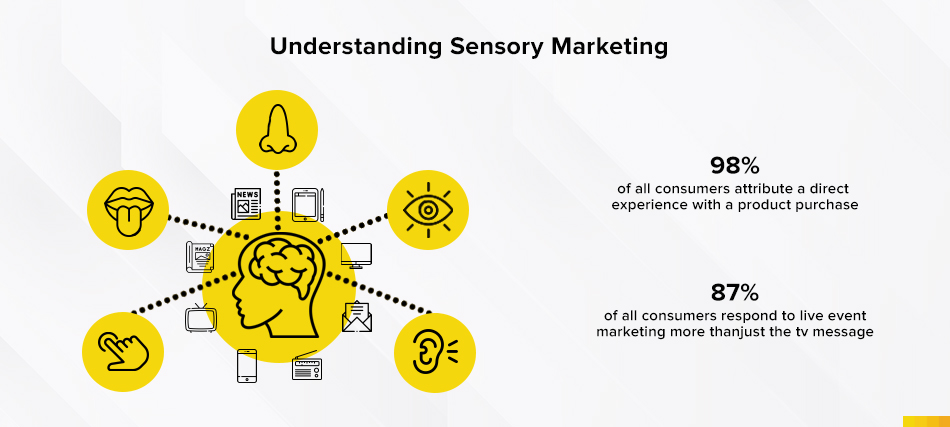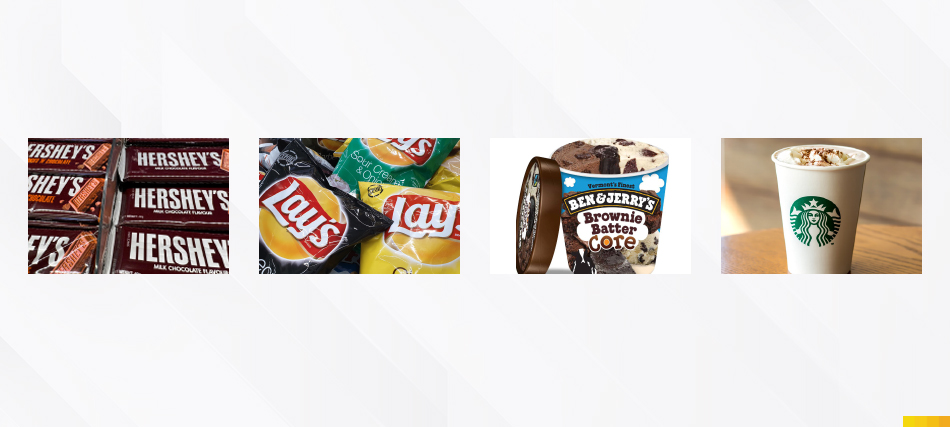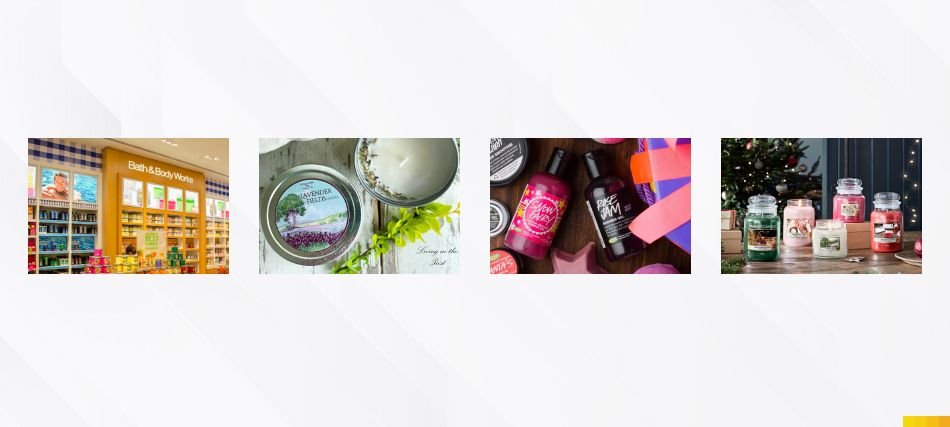Elevate your Brand engagement through sensory marketing. Explore real examples and boost your brand’s digital presence with sensory experiences
The average attention span of humans is 8 seconds and it is reducing day by day in this digital landscape. To capture the audience’s attention we need to implement Sensory marketing which offers a unique approach including the five senses—sight, sound, taste, touch, and smell.

Studies reveal that sensory experiences can boost brand recall by a remarkable 70%. It’s estimated that 90% of purchasing decisions are influenced by sensory factors, After the evolution of covid-19 pandemic, businesses are aiming to connect with their customers to a deeper level by evoking emotions in them.
Studies reveal that an appealing scent alone can increase sales by 45%. Sound, taste, and touch also play vital roles, with sound at 41%, taste at 31%, and touch at 25%. For ultimate loyalty (around 60%), products should stimulate multiple senses, when it depends on only one it drops loyalty to 30%


In this blog, let us delve into the new-age world of sensory marketing, exploring how it has evolved to captivate consumers, both offline and in the ever-expanding digital realm.
Sensory marketing creates a holistic brand experience by engaging the five senses. These sensory appeals resonate with the audience, influencing their perception and emotions towards a brand or product.

The senses play a pivotal role in decision-making, making sensory marketing a potent tool in today’s consumer-centric landscape.
Modern marketing extends beyond products and services; it’s about creating emotional connections. Many Brands excel at this by evoking a sense of belonging and adventure. Engaging emotionally with your audience sets the stage for appealing to their other senses, intensifying the brand experience.
Remember the iconic Nokia ringtone and still, it plays in our minds. People may forget brands but they don’t forget how brands make them feel. This is possible only by evoking sense in your marketing strategy.
While taste may seem challenging to replicate online, the digital realm offers innovative solutions. Digital menus have emerged as a popular tool, blending taste and style to entice food enthusiasts. Presenting visually appealing representations of dishes caters to the visual aspect, evoking the sensation of taste through imagery.

Some top brands that use this sense in their branding strategies are Ben & Jerry’s Ice Cream, Hershey’s Chocolate, Lays Potato Chips, and Starbucks Coffee
Audio has long been a part of advertising, leaving lasting imprints on memory. Companies create unique auditory identities through jingles, phrases, or specific sounds. Digital platforms allow for incorporating music into marketing strategies, leveraging pace, pitch, and volume to evoke emotions.
Intel Inside Jingle, Disney Theme Parks, Spotify Playlists and many other iconic brands use memorable music or soundtracks making it more attached to their audience.
In sensory marketing, sight reigns supreme. Striking visuals, logos, and colour schemes create immediate brand recognition. Utilising technologies like Augmented Reality (AR) and Virtual Reality (VR) adds depth, allowing consumers to interact with products, providing a new perspective and enhancing the brand experience.
In the food industry, businesses often use warm colours like red, orange, and yellow to attract customers. These colours are linked to happiness and excitement. Red, especially, stimulates hunger and metabolism. That’s why fast-food giants like McDonald’s, KFC, and Burger King use red in their logos and packaging

Incorporating touch in digital marketing is an evolving frontier. Haptic touch technology is emerging, enabling interaction through gestures and tactile feedback. While challenging, exploring multi-gesture apps and touch commands for enhanced online engagement is a step towards integrating touch into the digital realm.
Apple makes products that feel great to touch. Their phones, like the iPhone 13, can do different things when you touch them in different ways. If you touch the screen lightly, it does one thing, and if you press it harder, it does something else.

Aroma can trigger strong emotional responses and memories. In the digital sphere, evoking smell is intricate but possible. Associating products with specific scents through storytelling or creating mental imagery tied to aroma can simulate olfactory experiences in the minds of consumers.

Iconic Brands like Lush Cosmetics, Bath & Body Works, Yankee Candle, and Lavender Fields effectively use the sense of smell to create immersive and inviting environments, ultimately boosting their sales.
Sensory marketing is not confined to physical spaces; it’s an evolving art applicable in the digital landscape. Integrating sensory appeals into your online strategies creates a captivating and memorable brand journey. Consider your audience’s preferences and craft a sensory symphony that resonates with your brand’s essence.
Sensory marketing is not just a theoretical concept; many successful brands have implemented it to create memorable and immersive experiences for their customers.
Here are some real-life examples of brands that have mastered the art of sensory marketing:
- Dunkin’ Donuts – Smell and Sound: Dunkin’ Donuts is known in their South Korean outlets, they release the aroma of freshly brewed coffee into the air while playing their signature jingle. This combination of smell and sound created a powerful emotional connection with their customers, making the experience of visiting their store unforgettable.
- Coca-Cola – Sight: Coca-Cola is a prime example of using visuals to create brand recognition. Their red and white colour scheme and iconic logo are instantly recognizable all over the world. The use of colour and design in their branding plays a significant role in their sensory marketing strategy.
- Abercrombie & Fitch – Multiple Senses: Abercrombie & Fitch used a multisensory approach to boost sales in one of their South Korean outlets. They incorporated attractive visuals in their store design, played music to set the mood, and even released their signature fragrance into the air. This combination of sight, sound, and smell created an immersive brand experience that resonated with their customers.
- McDonald’s – Taste and Sound: McDonald’s has been using sensory marketing for years. The sound of sizzling burgers on the grill and the iconic jingle “I’m Lovin’ It” are ingrained in our memories. The taste of their food, combined with these auditory cues, creates a powerful sensory experience that keeps customers coming back.
- Lush – Touch and Smell: Lush, a cosmetics brand, takes advantage of touch and smell in their sensory marketing. They allow customers to touch and feel their products in-store, which are often handmade and have unique textures. Additionally, their products are known for their distinctive and delightful scents. The combination of touch and smell makes the shopping experience at Lush truly multisensory.
- ScentAir – Smell: ScentAir is a company that specializes in using scent for sensory marketing. They work with various businesses, including hotels and retail stores, to create custom scents that enhance their brand experience. For example, a luxury hotel might use a signature scent in its lobby to create a sense of opulence and relaxation.
These real-life examples demonstrate how brands across various industries have harnessed the power of sensory marketing to create memorable and emotional connections with their customers. Brands understand that engaging the senses is a key strategy for success in today’s competitive marketplace.
Sensory marketing is a potent tool that transcends traditional advertising. Engaging the senses immerses consumers in a multi-dimensional brand experience, fostering lasting connections.
Craft your brand’s unique sensory symphony with X-Verity, and let it resonate across the digital landscape, captivating hearts and minds in an unforgettable melody.